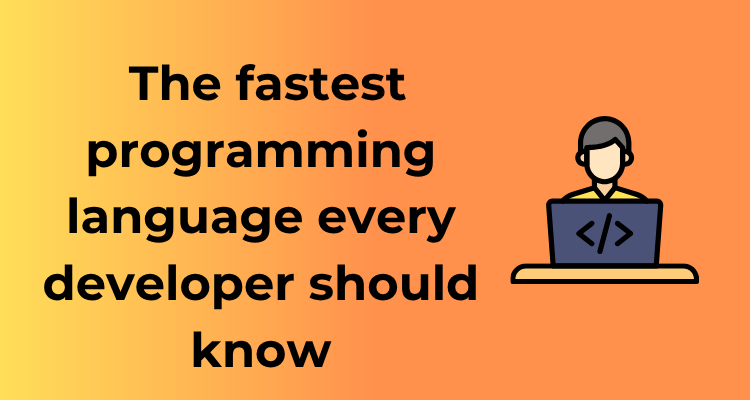When people talk about the “fastest programming languages,” what they’re really discussing is how efficiently a language can execute code to deliver results. But here’s the kicker: speed in programming can mean more than one thing! It’s like talking about “fast food” — are we focusing on how quickly it’s prepared or how quickly you can eat it?
Understanding Speed in Programming: What Does it Really Mean?
Speed in programming isn’t just about how fast code runs — it’s about efficiency at every level. From compile times and execution speed to memory usage and scalability, a programming language’s “speed” reflects how well it performs under different workloads. This article explores what programming speed truly means, the factors that influence it (like language design, compiler optimization, and runtime environment), and how developers can balance speed with readability, maintainability, and development time. Understanding these nuances helps programmers choose the right language and approach for each project, ensuring optimal performance and productivity.
In programming, speed falls into two main buckets:
- Execution Speed: This refers to how quickly the program runs once you’ve written the code. Think of processing data, rendering graphics, or even running simulations. For example, when your code has to handle thousands—or even millions—of tasks, execution speed becomes crucial.
- Development Speed: An entirely different animal! This measures how fast programmers can churn out functional, reliable code. For example, while Python isn’t necessarily the fastest in terms of execution, it’s often praised for allowing developers to write programs swiftly and concisely.
Now, what determines these speeds? A lot of variables come into play: the core design of the language, its compatibility with modern hardware, and even the overhead created during execution. If you’re picturing a racecar circuit, it’s kind of like the difference between a sleek Formula 1 car (high execution speed) and a high-tech assembly team in the pit lane (quick development and debugging).
Why Is Speed Important?
In the real world, speed isn’t just a “nice-to-have”; sometimes, it’s a necessity. For example:
- High-frequency trading platforms need milliseconds—or even microseconds—to execute trades before competitors.
- Gaming engines must render complex scenes at breakneck speeds to keep gameplay smooth.
- Massive data processing systems, like those behind your favorite social media networks, rely on blistering execution to deliver posts, likes, and videos almost instantly.
If a language lags behind, those applications might fail to deliver the performance users demand. Nobody likes a slow-loading website or laggy app, right?
The Key to Decoding Speed
Here’s the cool part: speed isn’t only up to computer scientists or engineers at colossal tech companies. It’s something developers like you and me can influence, too! Choosing the “right” language for the job is half the battle. Some languages, like C or Rust, are engineered for lightning-fast performance due to their low-level access to machine operations and minimal overhead. Others, like Python or Ruby, trade off some execution speed for simplicity and ease of use when writing code.
For example, imagine you need to build a simple survey tool quickly. Python might be the smarter choice because you’ll have it up and running in no time, even if it’s not the fastest runner in an execution-speed race. On the other hand, if you’re building a high-performance tool for weather simulations, you might want to lean on languages like C++ or Fortran to crunch numbers at blazing speeds.
Striking the Right Balance
Ultimately, understanding programming speed is about recognizing when and where it matters most. Think of it like driving: you don’t need a Ferrari for a quick grocery run, but when you’re racing on the Autobahn, that extra horsepower will make all the difference.
So before diving into a new project, ask yourself: “What kind of speed matters the most here?” Whether it’s execution or development speed, being intentional about your choice of language is what separates good developers from great ones!
Code Efficiency vs Compilation Speed: The Key Differentiators

Hello there! Let’s dive into a topic that often pops up in the world of programming: Code Efficiency versus Compilation Speed. If you’ve dabbled in coding or even just followed tech conversations, you’ve likely heard these terms get thrown around. But what do they actually mean, and how are they different? Grab a coffee, and let’s break this down into digestible bits!
What is Code Efficiency?
Code efficiency is essentially how well your program utilizes resources like CPU, memory, and energy. It’s about writing code that is not only functional but also optimized. Efficient code executes quickly, uses fewer system resources, and performs operations seamlessly. Think of it like driving a fuel-efficient car—it gets you far with less gas!
In our tech world, code efficiency often has a direct impact on the end user. Faster-loading apps, seamless gameplay, and smoother web experiences? You can thank developers who focus on efficient code. It’s the critical backbone of performance-sensitive systems like banking servers or AI algorithms that must analyze immense datasets in milliseconds.
Compilation Speed: The Other Puzzle Piece
Now, let’s talk about compilation speed. This term refers to the time it takes for the code you’ve written to be converted (“compiled”) into a language the machine understands. Imagine you’re translating a book into another language: the faster the translation is done, the sooner the readers can start enjoying it. That’s compilation speed in a nutshell.
Some programming languages are renowned for how quickly they compile, but here’s the kicker: a fast compilation process doesn’t always mean the resulting code will be the most efficient when executing. Languages like C and Rust, for example, tend to focus heavily on producing optimized machine-level code, which might slow down the compilation process a tad.
The Key Differentiators
- Purpose: Code efficiency improves how well your program runs, while compilation speed focuses on how quickly your program can be prepared to run.
- End Result: Efficient code saves resources during execution, but quick compilation speeds can save developers time during the development process.
- Trade-offs: In general, faster compilers might forgo deep optimization in favor of speed. On the flip side, compilers taking a longer time often result in highly tuned and efficient executable files.
Why Does It Matter?
So, which should you prioritize? Well, that depends on the scenario. If you’re developing software for resource-constrained environments—like IoT devices or real-time simulations—code efficiency is king. However, if you’re prototyping, working on hobby projects, or building something less sensitive to performance, compilation speed might take precedence. It’s all about context!
“Good developers balance the speed of coding, efficiency of execution, and the productivity of their workflow.” – A seasoned developer
Top-Notch Languages Known for Their Execution Speed

Let’s face it—nobody likes waiting around for code to run, especially when dealing with high-performance applications or large-scale systems. Whether you’re optimizing a game engine, running massive data sets, or crafting an operating system, speed isn’t just a preference—it’s a requirement. Today, we’re diving into some of the fastest programming languages out there, and what makes them such high-performers!
So, What Are the Heavy Hitters?
When it comes to execution speed, a few languages consistently rise to the top of developer discussions. Let’s look at them one by one:
- C: The undisputed champion of raw execution speed, C is often regarded as one of the fastest programming languages out there. Why? It’s a low-level language, sitting just a step above assembly code. This proximity to the hardware allows C to execute instructions faster than most modern alternatives. It’s widely used for system-level programming, kernels, and real-time applications. If speed is mission-critical, C rarely fails to deliver.
- C++: Building on the foundation of C, C++ offers object-oriented programming while retaining much of the original language’s speed. It’s a favorite among game developers and engineers in industries like robotics. The addition of templates and a standard library provides versatility without sacrificing too much performance.
- Rust: Known as the “modern C++,” Rust offers both safety and phenomenal speed. One key advantage? Rust doesn’t compromise memory safety, but it still compiles to machine code that executes faster than many languages. Its focus on zero-cost abstractions is why Rust is becoming the go-to for performance-critical applications.
- Go (Golang): Designed by Google, Go is fast and highly efficient. Its simplicity and garbage collection mechanism make it well-suited for scalable, concurrent software systems, like web servers and network programming. It’s not as close to the hardware as C or Rust, but it still packs some punch.
- Assembly Language: Okay, this one’s a wild card because it’s not a programming language in the traditional sense. Assembly is directly tied to machine-level instructions, making it blazing fast. If you have the patience and the need, Assembly can give you unparalleled performance.
What Gives These Languages the Edge?
The secret sauce behind these languages lies in a combination of factors:
- Low-Level Access: Many of these languages, especially C, C++, and Rust, are “closer to the metal,” meaning they allow direct manipulation of system resources like memory and CPU instructions.
- Efficient Compilers: Languages like C++ and Rust have super-optimized compilers that translate code into efficient machine instructions, leaving little room for wasted processing time.
- Minimal Overhead: Unlike some high-level languages (e.g., Python or Ruby), these are designed with little to no runtime interpretation, focusing instead on pure execution.
- Concurrency: For modern applications, efficient handling of concurrency (e.g., Go’s goroutines) plays a key role in speeding things up.
The Role of Machine-Level Optimization in Speed

Have you ever wondered what really gives some programming languages their blazing speed compared to others? A huge part of the answer lies in machine-level optimization. It’s like fine-tuning an engine to make a car go faster—it requires precision, a deep understanding of the machine, and sometimes, a bit of creative genius.
What Is Machine-Level Optimization?
Machine-level optimization is what takes your code from being “abstract instructions” to being raw, lean, and mean instructions a computer can execute with lightning speed. Computers, at their core, operate on machine code—those 1s and 0s. When you program in high-level languages like Python, Java, or even C++, those human-friendly instructions must eventually be translated into machine code. How efficient that translation is can vastly impact how fast your program runs.
This optimization process involves minimizing resource use, such as CPU cycles, memory bandwidth, and disk I/O, while maximizing performance. That’s why some languages and compilers focus deeply on machine-level optimizations, delivering blazing-fast execution times.
The Languages That Excel in Machine-Level Optimization
- C and C++: Known as system-level programming languages, C and C++ are champions of speed. Why? They provide low-level access to memory and system resources, allowing developers to truly optimize performance down to the bit!
- Rust: Rust has joined the ranks of speed demons because of its focus on zero-cost abstractions. This means you can write high-level code without sacrificing runtime performance.
- Assembly: Okay, this one isn’t for the faint-hearted, but coding directly in assembly essentially means you’re writing instructions almost directly for the CPU. It doesn’t get more “machine-level optimized” than that!
How Does Machine-Level Optimization Work?
Think of it like packing for a trip. If you’re not careful, you’ll overpack and waste space. Machine-level optimization ensures that every bit of code is packed efficiently, with no wasted effort. Here’s how it’s typically achieved:
- Instruction Pipelining: Modern CPUs can perform multiple operations simultaneously (you’ve probably heard of multi-core processors). Optimized code ensures the CPU executes many instructions in parallel without waiting.
- Cache Optimization: High-speed execution heavily depends on how well instructions and data are stored in and accessed from the CPU cache. Poor cache usage? Hello, delays.
- Loop Unrolling: Instead of executing a loop repeatedly, some compilers “unroll” loops into cleaner machine instructions to speed things up.
- Register Allocation: Variables are placed into CPU registers (the fastest way to store data temporarily) rather than slower main memory whenever possible.
Why Machine-Level Optimization Matters
In the real world, speed isn’t just about breaking records—it’s a necessity in many fields. Financial algorithms process billions of transactions daily, video games demand seamless graphics at 60+ frames per second, and real-time systems like those in self-driving cars operate under ironclad deadlines. Without machine-level optimization, these applications wouldn’t be feasible.
Real-Time Applications That Demand Speed
When we talk about programming languages and speed, it’s impossible to ignore the incredible demands of real-time applications. In these scenarios, every second—or even microsecond—counts. From mission-critical software to everyday conveniences, real-time applications are everywhere, and their need for blazing-fast performance is non-negotiable. Let’s dig into some of these real-time use cases, shall we?
Why Do Real-Time Applications Need Speed?
The fundamental requirement of real-time systems is their ability to respond to inputs or events within a tight, predefined time frame. If the system lags, the consequences can range from minor inconveniences to catastrophic failures. Speed isn’t just “nice-to-have” here—it’s absolutely essential. These applications must execute instructions “quickly” and “efficiently” without bottlenecks.
The Everyday Marvels: Real-Time Systems in Action
So where do these speed-critical systems come into play? Here’s a quick tour of some fascinating real-world applications you’ve likely encountered (or relied on!) today:
- Self-Driving Cars: Autonomous vehicles are the poster child of real-time programming. These cars need to process terabytes of data from sensors, cameras, and LIDAR systems in fractions of a second to make split-second decisions. Languages like C++ reign in this domain, thanks to their ability to deliver performance right at the hardware level.
- Stock Market Trading Platforms: You know how stock prices change in a blink of an eye? That’s because real-time trading systems process market events and execute trades in milliseconds—or less. Python often handles analytics, but speed-centric tasks are powered by C++ or Java.
- Medical Devices: From pacemakers to ICU monitors, real-time health devices depend on fast, reliable software. Imagine the dire consequences if a cardiac event were to zip past an unresponsive program!
- Gaming: Real-time multiplayer games wouldn’t be any fun if you had laggy controls or delayed rendering. Languages like C++ and Rust often come into play for gaming engines, enabling smooth experiences with low latency.
- Streaming Services: Ever experienced a perfectly-timed video stream? Behind the scenes, programming languages ensure buffer-free playback by optimizing real-time data processing and compression algorithms.
Why the Right Language Matters
Certain programming languages dominate in real-time application development because they strike a perfect balance between raw speed and low-level control. For many of these systems, the most popular choices include:
- C++: With its close-to-the-metal nature, predictable performance, and efficient memory management, it’s an obvious leader.
- Rust: The rising star in speed-focused programming, Rust adds memory safety without compromising on efficiency.
- Java: While not as fast as C++, its platform independence and Just-In-Time (JIT) compilation make it attractive for certain real-time systems.
Lessons for Developers
If you’re diving into building real-time applications, your choice of language and optimization techniques can make or break your project. Whether you’re running simulations for a satellite or working on a mobile app with live updates, always keep performance benchmarks in mind. Here’s a pro tip: Learn the strengths and nuances of hardware-level optimizations. It will elevate your programming and help you achieve true real-time responsiveness.
How Compiler Design Impacts Language Performance
Have you ever wondered why some programming languages feel lightning-fast while others seem to drag their feet? The secret sauce often lies in the design of their compiler! Yep, that behind-the-scenes masterpiece does a lot more than just turning code into something a machine can understand. Let’s unpack how compiler design contributes to the performance of programming languages, and how it impacts what you create as a developer.
First Things First: What’s a Compiler?
Alright, let’s start with the basics. A compiler is like a translator. Imagine you’re writing instructions in your native language, but the machine only understands its own language—binary or assembly. The compiler steps in, taking your fancy high-level code (think Python or C++) and converting it into a sleek, machine-readable version. This process can either make or break the performance of your program based on how well it’s optimized.
Key Traits of a Well-Designed Compiler
Not all compilers are created equal, and the way they’re designed significantly affects how fast your program runs. Here are some traits of high-performance compilers:
- Optimized Execution: Some compilers focus heavily on optimizing your code during the compilation process, removing redundancies and improving execution paths. The result? A lean, mean, blazing-fast machine code.
- Efficient Memory Management: A good compiler minimizes memory usage, ensuring that your program uses resources wisely without unnecessary bloat.
- Parallel Processing: Advanced compilers can prepare your program for parallel execution, boosting its speed significantly on multi-core processors.
- Just-in-Time (JIT) Compilation: Languages like JavaScript and Java use JIT compilers that convert code during runtime, striking a sweet balance between speed and flexibility.
These qualities make a world of difference when it comes to execution time. A poorly designed or outdated compiler can hold even a well-written program back, while a good compiler can push it to peak performance.
Compilation Speed vs Runtime Speed—What’s the Trade-Off?
Here’s an interesting twist: sometimes, there’s a trade-off between how fast a compiler works and how fast the program it produces runs. For example, interpreted languages like Python prioritize faster development and easier debugging, while compiled languages like C tend to focus on maximum runtime speed. You might notice faster results during development or coding in one language, but the execution might not be as swift. It’s about striking the right balance for your project!
Why It Matters to You as a Developer
Knowing about compiler design can help you make better decisions when choosing a language, especially for performance-critical applications like video games or financial algorithms. Here’s what you can do to leverage this understanding:
- Pick the Right Tool for the Job: If speed is crucial, go with languages that have compilers renowned for optimization—think C++, Rust, or Go.
- Understand Compiler Flags: Many compilers let you customize optimization levels. Learn to use these flags effectively to tailor the performance to your needs.
- Stay Updated: Compiler technology evolves rapidly, and new versions often come with better optimizations. Make sure your tools are up to date!
What Developers Say About Balancing Speed with Versatility?
When it comes to programming languages, developers often find themselves in a uniquely tricky position—choosing between raw speed and versatility. It’s a classic debate that’s echoed in coding communities, forums, and coffee-break chats worldwide. Let’s dive into what developers really think about this balance and why it matters so much in our fast-paced, innovation-driven world.
The Tug-of-War: Speed vs. Versatility
Ever heard the saying, “With great power comes great responsibility”? That mantra might as well apply to programming languages too. Languages like C and Rust are renowned for their blazing performance. They squeeze out every ounce of speed by working closely with hardware. But here’s the catch: they can feel like climbing a steep hill for developers working on diverse, high-level applications.
On the flip side, languages such as Python—or even JavaScript to an extent—offer incredible flexibility. Need a data science tool? Python’s got you. Want to power up a quick web app? JavaScript can handle it. However, their general-purpose nature sacrifices a chunk of the speed that more focused languages can provide.
What Developers Value and Why
So, how do developers settle on a trade-off? It often boils down to context—the type of project they’re tackling and what matters most to their goals. Here are a few nuggets of insight from experienced programmers:
- If performance is mission-critical: Developers building systems like real-time gaming engines or high-frequency trading platforms tend to lean toward faster languages. As one developer aptly put it, “When milliseconds matter, you don’t bargain with speed.”
- When adaptability is key: For those working on applications where integrating frameworks, rapid prototyping, or frequent updates are essential, a versatile, slower language might end up saving time (and sanity!) in the long term.
- The role of tooling and ecosystem: Many developers mention that the presence of a rich library ecosystem can sometimes outweigh a language’s raw execution speed. Why code from scratch when someone’s already done the heavy lifting?
Striking a Happy Medium
Some of today’s languages try to bring the best of both worlds. Go (Golang), for instance, is known for blending speed with a simple, versatile syntax. Similarly, Kotlin offers intuitive versatility while maintaining decent performance. These “middle ground” languages are popular among developers who need a balance without diving into extremes.
That said, experienced coders caution against chasing perfection. As one seasoned developer put it: “No language is all things to all projects. A wise developer considers the big picture—what’s good enough for the job and sustainable for their team.”









